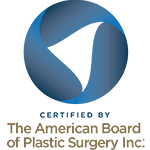Fat Grafting
Fat Grafting in Cosmetic Surgery
Fat grafting has helped to make significant advancements in cosmetic surgery over the past few years, becoming a highly effective and increasingly popular option for body contouring, facial rejuvenation, and volume restoration.
New advancements in fat transfer technology allow surgeons to use a patient's own fat to improve the contour of their face, breasts, and buttocks.
Autologous fat grafting / fat transfer
Autologous fat grafting is a surgical procedure in which a patient's own fat is harvested by liposuction and used to contour or augment another part of the body.
Autologous (meaning derived from the same individual) fat grafting is well suited for long lasting body contouring, and patients may prefer fat grafting over synthetic implants used in Breast Augmentation and Buttock Augmentation due to concerns over foreign body reactions, capsular contracture, or the desire for more natural outcomes. It also can be performed in patients who have breast implants to provide a softer more natural contour.
Dr. DiEdwardo describes the trend in women preferring breast shaping without the use of implants, and fat grafting is one option.
Fat grafting can also be used as part of a Facelift to restore lost volume in the cheeks. Fat transfer can be used to correct soft tissue depressions secondary to cellulite, trauma/scars or liposuction, as well as to restore lost volume of the labia majora.
Latest in fat transfer technologies
Advances in fat grafting technology provide improved fat survival, more precise treatments, and more natural-looking results than traditional methods. Dr. Hamori and Dr. DiEdwardo have adopted the latest devices for in-office fat harvesting and processing. These include:
- LipoCube™: This device provides new thresholds for minimal invasiveness for harvesting, filtering, concentration and transfer of a patient's fat tissue for various medical purposes.
- Puregraft: This single-use device used in the harvesting, filtering and transfer of patient fat ensures a sterile, high quality fat delivery with high tissue viability and predictable, consistent results.
What is nanofat grafting?
Nanofat grafting (fat transfer) is a cosmetic surgery treatment that uses the patient's own fat as an injectable. The process involves harvesting via liposuction a small amount of fat from the abdomen, lower back or inner thigh and mechanically mincing it up into a cell-less slurry of growth factors that is then injected into the superficial layers of the skin. Once deposited these growth factors signal local cells to rejuvenate the skin. The results are improved skin elasticity and smoothing of fine lines and wrinkles.
Dr. Hamori and Dr. DiEdwardo can also use nanofat grafting during facial surgeries, such as a Facelift, to improve skin quality and smooth fine lines on the cheeks and lips, restore volume to cheeks and boney deficiencies, treat fine lip lines, and to treat crepey skin under the neck.
This regenerative therapy is also useful in the treatment of Lichen Sclerosis with or without platelet rich plasma (PRP).
Advances in fat grafting technology provide improved fat survival, more precise treatments, and more natural-looking results than traditional methods.
Advances in fat grafting
In addition to a patient's own fat, Dr. Hamori and Dr. DiEdwardo can use off-the-shelf fat grafting products to achieve long-lasting results.
- Alloclae - This fat substitute closely mimics the consistency and texture of human fat that can be used as a standalone filler or in combination with fat grafting to restore lost volume in areas such as the face, hands, and body. It is particularly useful in situations where fat transfer may not be an option, such as for patients who may have insufficient fat stores for harvesting. It's also used for areas that require smooth volume restoration, such as the temples, cheeks, and jawline.
- Renuva - This processed human tissue provides a collagen-rich scaffold the provides structure that helps the body build new tissue around the scaffold. It does not replace fat, but supports fat grafts. Renuva is typically used to improve fat retention and graft survival, rather than as a standalone filler.


